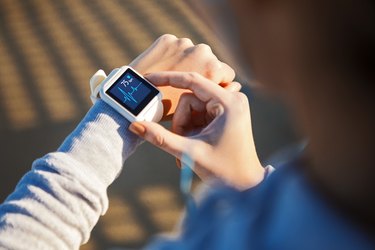
To us non-cardiologists, the heart can feel analogous to a metronome: There's a certain number of beats per minute, spaced out evenly, sometimes beating faster (like during a workout or stressful phone call) or slowing down (like when you're catching zzzs or settling into child's pose).
But just as the number of beats per minute can vary, so too does time between those beats. This variation is known as heart rate variability (HRV), and it's absolutely normal.
Video of the Day
Video of the Day
"Simply put, [heart rate variability is] the difference in time between one beat to another," says cardiologist Francoise Marvel, MD, assistant professor of medicine in the Johns Hopkins Division of Cardiology.
This time is glancingly brief: It's measured in milliseconds, Dr. Marvel notes. Say you're sitting on the couch and have a normal resting heart rate of around 60 beats per minute. That doesn't mean your heart is beating watch-like on the second — sometimes it's a bit faster (beating twice in a second), and sometimes it's a bit slower.
Many factors can affect this cardio metric, and whether your HRV is low or high can reveal quite a bit about your overall heart health. Here's what you need to know.
What Is Heart Rate Variability, Exactly?
You're likely accustomed to thinking about your pulse or heart rate, which is the number of times your heart beats in a minute — you can feel your heart rate if you put your fingers over a pulse point, and visually see it if you've ever had a EKG or been hooked up to a hospital monitor.
HRV is an altogether different measurement, and one that's a bit harder to notice.
"HRV is a value representing beat-to-beat variations in heart rate that is usually too minuscule to be detected by just feeling one's pulse or looking at a heart rate-detecting device," says Christopher Tanayan, MD, a sports cardiologist at Lenox Hill Hospital in New York City.
Check your pulse now, and if you don't have a rhythm disorder, you'll feel like "each beat comes around the same time as the next," Dr. Tanayan says. But that's not actually true: It's just that the variation is too slight for you to tell, he says.
The question of why your HRV matters requires a refresher course on the autonomic nervous system (ANS), which controls all sorts of body processes. Think back to science class, and you may recall two key parts of your nervous system:
1. Your 'fight-or-flight' response or sympathetic nervous system:
This adrenaline-driven system engages during moments of stress, Dr. Marvel explains. Think: A tiger suddenly appearing or your boss requesting an off-the-cuff presentation. In these situations, your heart rate increases, your arteries constrict and your muscles get lots of blood flow, Dr. Marvel says.
These physiological responses prep your body to race away from a tiger (or, in today's world, from your boss).
"When you have a really high level of your sympathetic nervous system turned on high, you are going to have faster heart rates, and less heart rate variability," Dr. Marvel says. When your heart is going really fast — say, 100 beats per minute — there's less space for variation between beats, she says.
Lions, tigers and bears are the traditional types of examples people provide for what engages your sympathetic nervous system because it's easy to understand why that would make your heart accelerate. But emotional stress, mental disorders and other factors can "drive that sympathetic fight-or-flight [response] to be present when there's no need for it. And that will lower heart rate variability," Dr. Marvel says.
2. Your 'rest-and-digest' or parasympathetic nervous system:
While your sympathetic nervous system revs you up, the parasympathetic nervous system does the reverse: a slowdown. In this setting, your heart rate is lower (this system is engaged when you're sleeping, after all), your arteries, arterioles and capillaries are relaxed and there's a nice blood flow, Dr. Marvel says. "Your heart is having a nice relaxed time of beating," she says.
With fewer beats each minute, there's more capacity for variation in the time between beats — so, when your parasympathetic nervous system is engaged, heart rate variability is higher.
The bottom line here: A lower HRV may be seen as negative for heart health — it's connected with cardiovascular disease and hypertension, and also seen with depression, anxiety and social and environmental determinants of health that keep you in a state of stress, Dr. Marvel says.
In contrast, when you have higher HRV (that is, more variation in the time between heart beats), you're less stressed, more relaxed and it's been connected with better cardiovascular fitness, Dr. Marvel says.
HRV vs. Arrhythmia
An arrhythmia is when you have an irregular heartbeat, per the Mayo Clinic. The heart beats too slow (bradycardia) or too fast (tachycardia).
An arrhythmia is an abnormal occurrence. In contrast, everyone experiences HRV. “Arrhythmia is an abnormal heart rhythm, whereas heart rate variability is a characterization of a normal heart rhythm,” Dr. Tanayan says.
How to Measure HRV
An electrocardiogram (ECG) can show your HRV.
"Manually measuring HRV requires one to use an ECG strip where you can see the spikes that represent each heartbeat. If you measure the distances between those spikes, you will find minute variations in the measurements," Dr. Tanayan says. That variation is your heart rate variability.
Using an ECG to measure HRV requires a trained clinician, Dr. Marvel says.
Another option — and one that doesn't require time in nursing or medical school — is a wearable heart monitor. That includes straps worn across your chest, and also fitness monitors such as series four or later Apple watches, Dr. Marvel notes.
"Wearable devices have the computing power to [measure the distances between heartbeats] for all the heartbeats you have for a period of wear time, and thus are able to give you a value that may differ from hour to hour or day to day," Dr. Tanayan says.
Wearables use two methods to measure HRV:
- Electrocardiogram (ECG): "ECG utilizes electrical signals to detect heartbeats," Dr. Tanayan says.
- Photoplethysmography (PPG): In this method, there's "an optical technique to detect blood volume changes in the microvascular bed of tissue representing pulsations created by heartbeats in the blood vessels," he says.
Are Apple Watches Accurate for Measuring Heart Rate Variability?
“Wearables such as the Apple Watch have both [methods of measuring HRV] and each method has its own advantages and disadvantages,” Dr. Tanayan says. But, as technology gets better, wearables will become more accurate, he says.
“We're still approaching all of these consumer-level options as opportunities to learn, but I would probably say the gold standard is to have an ECG that you're looking at and counting between the views,” Dr. Marvel says.
As a cardiologist, Dr. Marvel recommends tracking your HRV with guidance and input from your clinician. That way, “you're interpreting this in ways that are meaningful and helpful for you as an individual,” she says.
How Is HRV Connected to Your Health?
Think of HRV as an indicator.
"It actually is not something that affects your health but is sort of an effect of your health," Dr. Tanayan says. It reflects your autonomic nervous system status, he adds.
And unlike the heart rate, where there are guidelines as to what's normal and what's not, there aren't specific cutoffs to denote a normal or poor range, Dr. Marvel says.
"What we know is that the higher the variability between each beat can suggest that these patients have better cardiac fitness," Dr. Marvel says. People with no or low variability are more likely to be sedentary, she says.
And, as noted above, lower heart rate variability is connected with heart disease, high blood pressure, depression, anxiety and high levels of stress.
Factors That Affect Heart Rate Variability
Anything that affects your overall heart health could affect your HRV. "Cardiovascular factors that can affect or influence cardiovascular risk also influence heart rate variability," Dr. Marvel says. That includes — but is not limited to — the following:
- Lifestyle factors: What you eat is so significant to overall heart health; fitness and activity levels are as well. Another factor involved in heart health: social determinants of health (SDOH), which are "nonmedical factors that influence health outcomes" per the Centers for Disease Control and Prevention (CDC). This includes the conditions where you live and work, along with overarching forces like economic systems, racism and climate change.
- Sleep: Imagine a scenario of working a night shift and not getting sufficient sleep, Dr. Marvel says. With a circadian rhythm that's gone askew, HRV may fall due to anxiety and stress and hypertension and a higher resting heart rate, she says.
- Age: HRV tends to lower with age, Dr. Marvel notes.
- Sex: "Men tend to have more heart rate variability than women," Dr. Marvel says.
- Diseases and medications: Many conditions — as far-ranging as diabetes and depression — can have an affect on a person's heart, and therefore HRV, Dr. Marvel says. Some medications can also affect heart health.
- Stress management: Stress, which can kick off that fight-or-flight response, per the American Heart Association, could also be a factor.
- Genes: There's also likely a genetic factor involved, Dr. Marvel notes. "Genes are a really key part of the way that health unfolds for individuals," she says.
How to Improve Your HRV
There's no secret sauce to improving your HRV. Just about anything you'd do to improve your overall heart health — cutting down on stress, getting good sleep, following a heart-healthy diet and so on — will improve your HRV.
"Anything that may cause imbalance in the autonomic nervous system influences the HRV," Dr. Tanayan says — so, if you're stressed, sleeping poorly and so on, it can reduce HRV because it's activating your sympathetic nervous system, he says.
What helps improve heart rate variability:
- Exercise: "Exercise training remodels the heart and causes subsequent changes in the parasympathetic system," Dr. Tanayan says. That is, workouts mean your heart is more efficient, and beats less frequently. "This is why athletes have a very low resting heart rate," he says.
- Healthy living: That would include what you eat and drink, and avoiding stimulants and depressants (think: alcohol) as well as your sleep habits, Dr. Tanayan says.
- Mental health: Managing your stress can help improve HRV, per the Cleveland Clinic. If you have conditions like depression or anxiety, managing them is also important to HRV.
Frequently Asked Questions About HRV
What Is HRV Training?
"HRV training is structuring one's exercise schedule and regimen based on HRV," Dr. Tanayan says.
That is, because you know your HRV may be affected by certain factors — such as stress levels or workout recovery — you can opt to exercise when HRV is on the rise after recovery time, he says.
"This may not be very useful for casual exercisers, but intense long-term athletic training that puts a prime on efficiency and effectiveness of exercises may utilize HRV more to meet specific targets," Dr. Tanayan says.
When Should You See a Doctor About HRV?
While it's good to have high heart rate variability, "a low HRV by itself does not automatically mean you are ill," Dr. Tanayan points out.
Plus, many of us don't know our HRV. If you do have a wearable heart monitor, you might have more insight — but even if a wearable notes a low HRV, it could be the result of wearing it wrong, or an imperfect device.
That said, "a lower-than-usual HRV may signify poor physical and/or mental health," Dr. Tanayan says. So if your HRV is low, and you also have symptoms of being ill, "consider seeing your physician," he says.
Bottom Line
Your HRV can be a window into your heart and overall health, with the goal generally being to have high HRV.
And wearables can give you a peek into your HRV at various moments, Dr. Marvel says. This kind of biofeedback could be potentially interesting and motivating to make health improvements, she says. But she encourages people to think of HRV and HRV training as something that's meaningful in addition to standard best practices for cardiovascular health.
Was this article helpful?
150 Characters Max
0/150
Thank you for sharing!
Thank you for your feedback!
Is this an emergency? If you are experiencing serious medical symptoms, please see the National Library of Medicine’s list of signs you need emergency medical attention or call 911.




